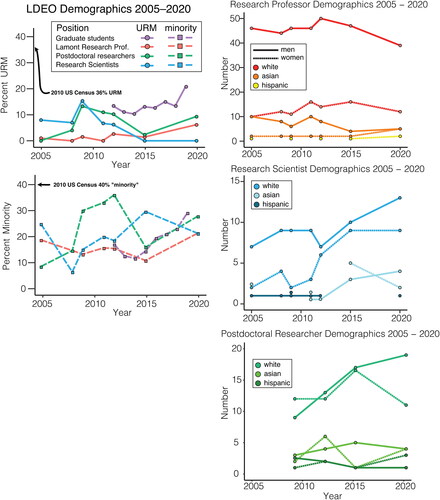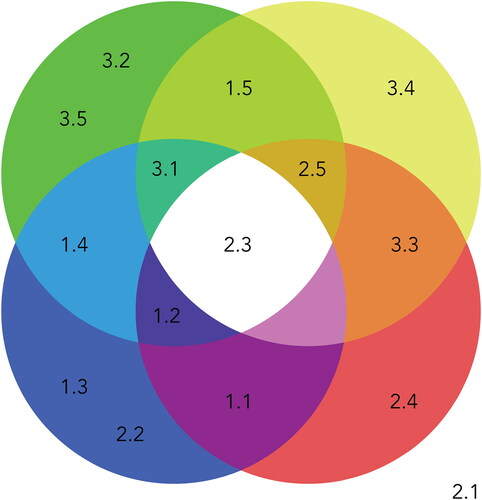Figures & data
Figure 1. Lamont Diversity, Equity, and Inclusion Task Force Makeup 2020. The Lamont Diversity, Equity, and Inclusion Task Force was appointed by the administration and made up of 18 members, four exofficio members, and three co-chairs from different levels of the Lamont community. (a) Task Force Composition. The composition is broken up by position, institute, and division; (b) Working Group Process. The second phase of the Task Force process, Working Groups, was determined after five iterations of practice rounds with different groupings of Task Force members until the final Working Groups were free of harmful power dynamics and optimal for research progress; (c) Working Group Template. Each Working Group worked through this template to develop ideas and compile resources around their Working Group theme.

Figure 2. Institutional DEI History and Task Force Timelines. (a) Lamont’s history of action on DEI started in 2005, with the ADVANCE grant, which focused on institutional transformation and increasing the number of women scientists. As a result of the ADVANCE program, the Office of Academic Affairs was established in 2008, new search committee guidelines were implemented in 2009, and the Research Professor track was established and expanded in 2010. Other DEI actions were spearheaded by the Office of Academic Affairs and Diversity (OAAD) after its creation, but the next largest institutional step focusing on DEI was not until July 2020, when the LDEI Task Force was created. The Task Force Report of recommendations for institutional and individual action on DEI was delivered to the administration on January 15, 2021. After this, the Task Force was no longer in action (the vertical red line denotes the end of the LDEI Task Force); (b) Lamont Diversity, Equity, and Inclusion Task Force Process. The Task Force was created in July 2020 and began with Information Gathering, doing research on DEI actions and running practice working groups (see ). After deciding on four specific themes around which to organize, we split into Working Groups to deeply delve into themes to create specific recommendations. Report writing commenced in October, and culminated in a Report that was delivered to the administration on January 15, 2021.

Table 1. Example of a few compiled priorities, SMART goals, and recommendations.
Figure 3. LDEO Demographics 2005–2020. Data from OAAD, Citation2020 and the Department of Earth and Environmental Sciences (DEES). Graduate student demographics, provided by DEES, is in the format used for reporting to the NSF/National Institutes of Health, and as such includes US citizens only. All other populations shown here (Research Professors, Postdoctoral Researchers, Research Scientists) include people of any nationality. The left column shows compiled demographics from 2005 to 2020 in percent URM and percent minority for Graduate students, Lamont Research Professors, Postdoctoral Researchers, and Research Scientists. The right column shows numerical demographics broken down by position, race, and binary gender for Lamont Research Professors, Research Scientists, and Postdoctoral Researchers from 2005 to 2020.

Figure 4. Working Groups and Priorities. Graphical representation of the four Working Groups and the Priorities that were synthesized from their recommendations. Yellow circle, upper right - Inclusive Culture. Green circle, upper left - Supporting Success. Red circle, lower right - Recruitment, Retention, and Promotion. Blue circle, lower left - Building Bridges. The numbers refer to each of the Key Priorities, some of which were drawn from multiple different working group recommendations, as indicated by the overlapping areas in the figure. The full list of Priorities is available in the Supplement.

Table 2. Task Force Working Groups—focus areas and results.
